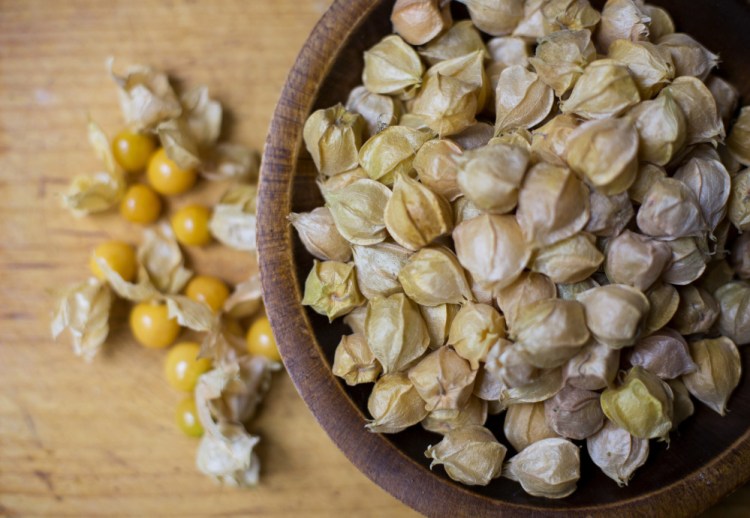I am a ground cherry evangelist.
It was four years ago, after we’d relocated to Maine, that I found my first pint. They’d been foraged, and were sitting by themselves next to the cash register at The Rockport Marketplace. They looked like tiny, pale reproductions of the bright-orange hanging fruit of the Chinese Lantern stems I’d placed in my freshly painted, gray-and-white living room for a pop of color.
The clerk let me taste one. I pulled back the papery husk and found a fruit looking like an under-ripe sungold cherry tomato, which set the stage for what I thought they might taste like. I was wrong. The shiny skin of the berry popped to a sweet but earthy front-end flavor (kind of like really ripe pineapple) that finished with the slight acidity of their nightshade family cousins, the tomatillos, and a crunch of lots of seeds, like you get with strawberries.
Called Physalis pruinosa by botanists, and husk cherries, ground cherries, husk tomatoes, Inca Berries (they are native to Peru), and Cape Gooseberries (South Africans transplanted them wildly) more colloquially, the berries are really just prolific weeds. They go from seedling to dropping fruit in under 80 days, an indication that the cherries are ripe and ready to eat. At that point, the husks should be dry and the fruit yellow-orange.
 It was two years before I found my next pint. Whatley Farm in Topsham started selling them, grown from seeds purchased in the Johnny’s Selected Seeds catalog. I could buy them by the quart come mid-August: eating them as I walked home from the market; keeping a bowl on my counter for all to try; serving them as palate cleansers at dinner parties; incorporating them into favorite dishes (see Cornbread recipe); and unabashedly telling fellow shoppers I didn’t even know, “You’ve just GOT to try these.”
It was two years before I found my next pint. Whatley Farm in Topsham started selling them, grown from seeds purchased in the Johnny’s Selected Seeds catalog. I could buy them by the quart come mid-August: eating them as I walked home from the market; keeping a bowl on my counter for all to try; serving them as palate cleansers at dinner parties; incorporating them into favorite dishes (see Cornbread recipe); and unabashedly telling fellow shoppers I didn’t even know, “You’ve just GOT to try these.”
No agency is tracking sales numbers of ground cherries, not yet anyway, but I’ve spotted them at farmers markets in Brunswick, Portland, Boothbay and Yarmouth this summer alone, ranging in price from $3.50 to $5.50 per pint. All of which made me wonder whether it is a sustainable practice to take a previously foraged food item and eat it like it’s going out of style.
Here’s the problem with foraging: when an item becomes popular: People overharvest it so the wild species diminishes or disappears, said Jason Lilley, sustainable-agriculture professional with the University of Maine Cooperative Extension in Falmouth. Think ramps. “Fortunately for … your love of ground cherries, I see no concerns in cultivating this delicious crop,” he added. Ground cherry seeds are distributed by seed companies across the country, he said, which means both that a lot of the species is around and also that growers can select varieties that taste best and resist disease.
In a forum on this topic posted on The Resilience Hub’s site, Maine mushroom forager David Spahr wrote that ground cherries you find at the market in this area are more likely to be cultivated than wild. He suggested collecting wild seeds and using those to start the species in your garden, as they’ll grow better than cultivated varieties, need little maintenance and typically produce more fruit. No harm done to the wild species, he said. Another forum participant warned that each wild-to-cultivated species, especially if they are prolific and self-renewing, should be evaluated individually for their effect.
So while I’ve got the green light on ground cherries, I’ll yield to the yellow-light warning before evangelizing my next farmers market find until I know it’s safe to do so.
Christine Burns Rudalevige is a food writer, a recipe developer and tester, and a cooking teacher in Brunswick. Contact her at: cburn1227@gmail.com.
Send questions/comments to the editors.



Success. Please wait for the page to reload. If the page does not reload within 5 seconds, please refresh the page.
Enter your email and password to access comments.
Hi, to comment on stories you must . This profile is in addition to your subscription and website login.
Already have a commenting profile? .
Invalid username/password.
Please check your email to confirm and complete your registration.
Only subscribers are eligible to post comments. Please subscribe or login first for digital access. Here’s why.
Use the form below to reset your password. When you've submitted your account email, we will send an email with a reset code.